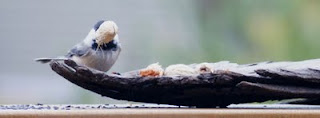 As the days get longer, some of the birds that were gregarious cooperative participants in the local "guild" of birds all winter are showing up at the feeders in pairs. Unlike in the very cold weather when they had to help each other find food and keep warm, now they are beginning to define territories.
As the days get longer, some of the birds that were gregarious cooperative participants in the local "guild" of birds all winter are showing up at the feeders in pairs. Unlike in the very cold weather when they had to help each other find food and keep warm, now they are beginning to define territories.The Downy woodpecker pair (above) and the larger Hairy woodpecker (below) will probably select their nest sites in the next three or four weeks. Meanwhile, they appreciate the suet feeders.
























 The kitchen garden at the edge of the wild woods produces a precarious harvest of veggies when the grazing deer stay outside the rabbit fence. On most afternoons there are just enough tomatoes, summer squash, beans, snow peas, or leafy greens ripe for our small suppers.
The kitchen garden at the edge of the wild woods produces a precarious harvest of veggies when the grazing deer stay outside the rabbit fence. On most afternoons there are just enough tomatoes, summer squash, beans, snow peas, or leafy greens ripe for our small suppers.



